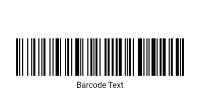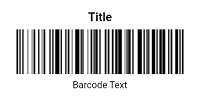Code 128C is a subset of the Code 128 barcode symbology designed for efficient encoding of numeric data. It is part of the Code 128 family, which includes several subsets optimized for different types of data. Code 128C specifically targets applications where numeric-only data needs to be encoded in a compact and high-density format.
Developed in 1981 by Computer Identics, Code 128 was introduced as a versatile and efficient barcode symbology capable of encoding the full ASCII character set. Code 128C was created to provide an optimized solution for numeric data, offering a more space-efficient alternative to other numeric barcodes like Code 39.
Technical Specifications
Code 128C is designed to encode numeric data exclusively, allowing for the representation of digits from 00 to 99. The symbology uses a combination of bars and spaces of varying widths to encode each digit, achieving high-density encoding.
The structure of Code 128C includes:
- Start Character: This signifies the beginning of the barcode and indicates that the data will be encoded using Code 128C.
- Data Characters: Each pair of digits is represented by a compact pattern of bars and spaces, making the encoding process more efficient compared to other subsets of Code 128.
- Checksum: A modulo 103 checksum is calculated and appended to the end of the data to ensure accuracy and detect errors.
- Stop Character: This marks the end of the barcode, allowing scanners to recognize when the data sequence is complete.
Checksum Calculation
The checksum for Code 128C involves several steps to ensure data integrity:
- Assign a value to each character based on its position in the Code 128C character set.
- Multiply each character’s value by its position index (starting with 1 for the first character).
- Sum these weighted values.
- Compute the remainder when this sum is divided by 103.
- The resulting value is the checksum character, which is appended to the data before the stop character.
This method helps in verifying the accuracy of the encoded data, reducing the likelihood of scanning errors.
Advantages and Disadvantages
Code 128C offers several advantages, including its high-density encoding of numeric data, which reduces the amount of space required compared to other numeric barcodes. Its efficiency makes it ideal for applications where space is at a premium, and its inclusion of a checksum enhances data accuracy and reliability.
However, Code 128C is limited to numeric data only, which restricts its use in applications that require alphanumeric characters or special symbols. Additionally, the complexity of encoding and decoding may require more advanced equipment compared to simpler barcode types.
Code 128C Applications
Code 128C is used in a variety of settings where efficient numeric encoding is required:
- Logistics and Shipping: Often used to encode tracking numbers or other numeric data in a compact format, facilitating efficient scanning and processing in shipping and warehousing.
- Retail: Applied in scenarios where high-density numeric data is needed for product identification or inventory management.
- Manufacturing: Utilized in production environments to encode serial numbers or batch codes, aiding in tracking and quality control.
Comparison with Other Barcode Symbologies
Compared to other numeric barcodes, such as Code 39 or UPC, Code 128C offers a more compact and efficient solution for encoding numeric data. Unlike Code 39, which can encode both numbers and letters but requires more space, Code 128C is optimized for numeric data and achieves higher density. Compared to UPC-A, which is primarily used for retail items and offers less flexibility, Code 128C provides a more versatile option for applications requiring compact numeric encoding.
Code 128C provides an efficient and space-saving solution for encoding numeric data, making it a valuable tool in logistics, retail, and manufacturing applications. Its high-density encoding and error-checking capabilities ensure accurate and reliable data capture, while its limitation to numeric data and potential complexity in implementation are considerations for its use. As part of the Code 128 family, Code 128C represents a specialized option for scenarios where compact numeric encoding is essential.


